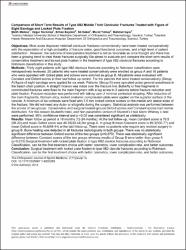| dc.contributor.author | Malkoç, Melih | |
| dc.contributor.author | Korkmaz, Özgür | |
| dc.contributor.author | Bayram, Erhan | |
| dc.contributor.author | Şeker, Ali | |
| dc.contributor.author | Yılmaz, Murat | |
| dc.contributor.author | İşyar, Mehmet | |
| dc.date.accessioned | 10.07.201910:49:13 | |
| dc.date.accessioned | 2019-07-10T19:37:16Z | |
| dc.date.available | 10.07.201910:49:14 | |
| dc.date.available | 2019-07-10T19:37:16Z | |
| dc.date.issued | 2014 | en_US |
| dc.identifier.citation | Malkoç, M., Korkmaz, Ö., Bayram, E., Şeker, A., Yılmaz, M. ve İşyar, M. (2014). Comparison of short term results of type IIB2 middle third clavicular fractures treated with figure of eight bandage and locked plate fixation. Orthopaedic Journal of Sports Medicine, 2(11). https://dx.doi.org/10.1177/2325967114S00265 | en_US |
| dc.identifier.issn | 2325-9671 | |
| dc.identifier.uri | https://dx.doi.org/10.1177/2325967114S00265 | |
| dc.identifier.uri | https://hdl.handle.net/20.500.12511/1368 | |
| dc.description.abstract | Objectives: Most acute displaced midshaft clavicular fractures conventionally have been treated nonoperatively with the expectation of a high probability of fracture union, good functional outcomes, and a high level of patient satisfaction. However, the outcome of nonoperative treatment is not as favorable as once thought and there has been a growing trend to treat these fractures surgically We aimed to evaluate and compare the short term results of conservative treatment and locked plate fixation in the treatment of type IIB2 clavicula fractures according to Robinson classification in this study. Methods: Thirty eight patients with type IIB2 clavicula fractures according to Robinson classification were retrospectively reviewed. 20 patients who were treated conservatively were enrolled as group A and 18 patients who were operated with locked plate and screws were enrolled as group B. All patients were evaluated with Constant and Oxford scores in their last follow up control. For the patients that were treated conservatively (Group A) figure of eight bandage were applied for six week. Patients (Group B) were operated under general anesthesia in the beach chair position. A straight incision was made over the fracture line. Butterfly or free fragments in comminuted fractures were fixed to the main fragment with a lag screw in 3 patients before fracture reduction and plate fixation. Fracture reduction was performed with taking care of minimal periosteal stripping. After reduction of the main fragments, titanium alloy, locked anatomic compression plate were applied on the superior surface of the clavicle. A minimum of six cortexes were fixed with 3.5 mm locked cortical screws on the medial and lateral sides of the fracture. We did not need any Auto- or allografts during the surgery. Statistical analysis was performed between the scores of two groups. Conservative and surgical treated groups Oxford scores and Constant scores had normal distribution. For this reason Student's t test, and Non-parametric version of Student’s t test Mann Whitney U test were performed. 95% confidence interval and p <0.05 was considered significant as statistically. Results: Mean follow up period is 18 months (12-24 months). At the last follow-up, mean Constant score is 79.5 (98-43) and mean Oxford score was 46.35(49-44) for group A. In group B mean Constant score is 89.3(100-77) and mean Oxford score is 46,6(48-44) at the last follow-up. There were no patients who require any revision surgery in group B. Bone healing was detected in all fractures radiologically in both groups. There was no statistically significant difference between Oxford scores of the two groups (p=0,570). There was statistically significant difference between Constant scores of the two groups whereas results of Group B were better than group A (p=0,013) Surgical treatment with locked plate fixation in type IIB2 clavicle fractures according to Robinson Classification, can be the first treatment choice with better cosmetics, lower complication rate, and better outcomes. Conclusion: Surgical treatment with locked plate fixation in type IIB2 clavicle fractures according to Robinson Classification, can be the first treatment choice with better cosmetics, lower complication rate, and better outcomes. © The Author(s) 2014. | en_US |
| dc.language.iso | eng | en_US |
| dc.publisher | SAGE Publications Ltd | en_US |
| dc.rights | info:eu-repo/semantics/openAccess | en_US |
| dc.rights | Attribution-NonCommercial-NoDerivs 3.0 Unported | * |
| dc.rights.uri | https://creativecommons.org/licenses/by-nc-nd/3.0/ | * |
| dc.subject | Bandage | en_US |
| dc.subject | Locked Plate Fixation | en_US |
| dc.subject | IIB2 | en_US |
| dc.title | Comparison of short term results of type IIB2 middle third clavicular fractures treated with figure of eight bandage and locked plate fixation | en_US |
| dc.type | other | en_US |
| dc.relation.ispartof | Orthopaedic Journal of Sports Medicine | en_US |
| dc.department | İstanbul Medipol Üniversitesi, Tıp Fakültesi, Cerrahi Tıp Bilimleri Bölümü, Ortopedi ve Travmatoloji Ana Bilim Dalı | en_US |
| dc.authorid | 0000-0002-4843-5121 | en_US |
| dc.authorid | 0000-0001-7068-2033 | en_US |
| dc.authorid | 0000-0003-1259-6668 | en_US |
| dc.authorid | 0000-0001-9052-4411 | en_US |
| dc.identifier.volume | 2 | en_US |
| dc.identifier.issue | 11 | en_US |
| dc.relation.publicationcategory | Diğer | en_US |
| dc.identifier.doi | 10.1177/2325967114S00265 | en_US |
| dc.identifier.scopusquality | Q2 | en_US |



















